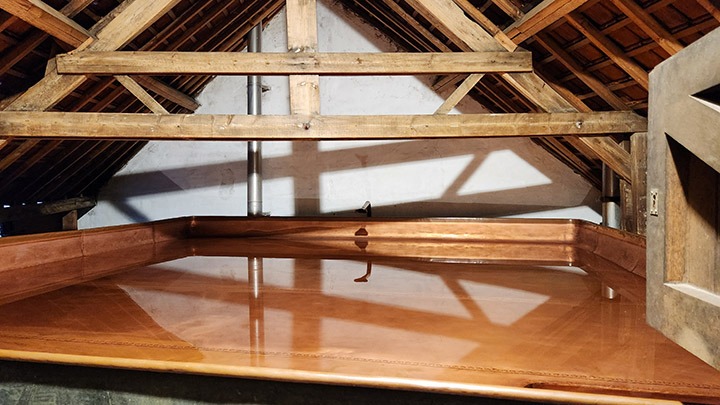Souring Sources
Q: I recently watched one of your BYO+ videos about making sour beer. The suggestion to use kimchi for souring beer blew my mind! I’m already making my own kimchi, so I will definitely try this. Here are my questions: 1. Is there any taste difference between using kimchi and the Lactobacilli that I can purchase from a lab? 2. If kimchi works, what about traditionally soured dill pickles, e.g., Strubbs?
— Gord Maxwell, via Live Chat
Mr. Wizard Says…
A: I recently talked about this during a BYO Live Chat and thought it would be worthwhile to share some expanded thoughts in writing. Let’s start with the idea of using kimchi as a source of bacteria for making sour beer. As a probiotic-rich food, kimchi is a well- established source of various microorganisms believed to promote gut health (Indigenous Fermented Foods for the Tropics is a great reference on this). These microbes, many of which are lactic acid bacteria, also happen to be useful in the production of sour beer.
The primary organisms responsible for kimchi fermentation belong to the gram-positive, acid-producing Lactobacillaceae family of bacteria, often referred to more simply as lactics. This large and diverse group of bacteria is naturally found in many places, including grains, fruits, vegetables, and even in puddles of fermenting spilled milk. One particularly interesting trait of lactics is that many are heterofermentative, meaning they produce multiple byproducts during fermentation. Depending on fermentation conditions, these byproducts typically include lactic acid, ethanol, and acetic acid. This contrasts with homofermentative lactics, which mainly produce lactic acid. That’s enough nerding out for now.
These days, most sour beers are produced using one of two general approaches: Either by purchasing lab-grown cultures or by channeling your inner Tarzan and wrangling wild bugs. Traditional sour beers rely heavily on the Tarzan method, where wort is naturally inoculated by airborne microbes, ingredients, and the unique microflora found in the brewing environment. One of the best-known examples of this method is used by Brasserie Cantillon in Brussels, Belgium. They are legendary for their exceptional wild ales, which have been brewed using largely unchanged techniques for nearly a century. Their brewery sits tucked away in a charming neighborhood surrounded by butcher shops, cafés, and rows of townhouses, blending the old-world craft of spontaneous fermentation with the bustle of modern life.

In more recent years, brewers have adapted this traditional approach by using fermented foods — especially yogurt and kefir — as alternative sources of bacteria for kettle sours. Although these cultured dairy products are often made with blends of commercially available bacteria, to the brewer they are still considered somewhat wild, since the exact composition of the cultures isn’t usually known when added to wort. This adds a layer of unpredictability, which can be both exciting and risky.
Over the past 25 years or so, access to specialty cultures of bacteria and yeast has grown dramatically. Today, brewers looking for consistency and control in their funky beers have a wide range of commercial options. In the early days, most of these lab cultures were blends of organisms found in traditional Belgian lambics or blends intended to approximate bugs found in lambics. As time went on, the push for more predictable and faster souring methods led to the rise of kettle souring. This process is popular because it allows brewers to keep the souring bugs contained in the brewhouse, rather than introducing them into the fermentation cellar where cross-contamination is a concern.
Because malt is such a rich source of lactic acid bacteria — including Lactobacillus delbrueckii, which is homofermentative, and Lactobacillus plantarum, which is heterofermentative — many early kettle souring techniques relied on bugs cultured directly from malt. Today, however, brewers can easily purchase pure lactic cultures from yeast labs. These have largely replaced wild-cultured sources, especially for brewers seeking repeatability and ease of use.
More recently, lactic acid–producing yeast strains have gained popularity. Lachancea thermotolerans is a naturally occurring yeast that produces both lactic acid and ethanol and is now available to homebrewers and commercial brewers from yeast labs such as Escarpment Labs and Lallemand. Lallemand also offers a genetically modified Saccharomyces cerevisiae strain known commercially as Sourvisiae. This strain has been engineered to express the gene for lactate decarboxylase, an enzyme that converts pyruvate to lactic acid. The main advantage of using Lachancea or Sourvisiae in sour beer production is the simplified process compared to kettle souring, with no bacteria introduced into the cellar.
All of this helps explain why the idea of going Tarzan with kimchi as a source of lactics is so appealing for brewers looking for an adventure. Fresh kimchi juice contains a healthy population of lactic acid bacteria. According to the kimchi chapter in Indigenous Fermented Foods from the Tropics, cell densities in kimchi typically range from 100 million to 1 billion cells per milliliter. That’s an ideal range for brewers looking to propagate a strong bacterial culture for use in beer. You’ve got plenty of biological firepower in even a small splash of kimchi juice to propagate for use in brewing.
Kimchi is just one of many fermented foods that can be used to wrangle bugs for making sour beer. My general advice is to start with foods that taste good to you. If you wouldn’t eat it, don’t brew with it. Live sauerkraut, buttermilk, and dill pickles are all viable sources of lactics.
One final, important tip: If you’re working with heterofermentative lactics, avoid creating conditions that lead to the production of acetic acid (aka vinegar). These bacteria only make acetic acid in the presence of oxygen, so be sure to minimize oxygen exposure during the souring phase



